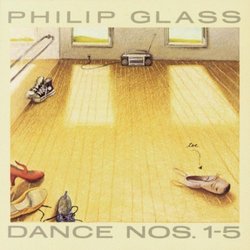| All Artists: Michael Riesman, Philip Glass Ensemble, Michael Reisman, Iris Hiskey Title: Philip Glass: Dances Nos. 1-5 Members Wishing: 2 Total Copies: 0 Label: Sony Release Date: 10/25/1990 Genres: Dance & Electronic, Classical Styles: Techno, Ballets & Dances, Ballets, Historical Periods, Modern, 20th, & 21st Century Number of Discs: 2 SwapaCD Credits: 2 UPC: 074644476521 |
Search - Michael Riesman, Philip Glass Ensemble, Michael Reisman :: Philip Glass: Dances Nos. 1-5
 | Michael Riesman, Philip Glass Ensemble, Michael Reisman Philip Glass: Dances Nos. 1-5 Genres: Dance & Electronic, Classical
|
Larger Image |
CD Details |
CD ReviewsA must have..... Brett Stewart | Madison, WI United States | 09/11/2001 (5 out of 5 stars) "This album is somewhere between Einstein on the Beach and Glassworks, both chronologically, and artistically. It features the relentlously spinning arpeggios of Einstein, and the more easily digestable charm of Glassworks.In Dances, Philip Glass creates a sound world all to its own, and incapulates you in it. You get lost and then suddenly realize that you like being lost within the chords. When each dance finally ends, you are left wanting more. This feeling is impossible to describe, but Glass fans find nothing more satisfying that going into this world. If you get this feeling when you listen to Glass then you are seriously missing out if you do not have this recording, and for anyone who wants to experiement with Glass, this is a great place to start. If you are unsure, get Glassworks, and then get this cd. Either way, GET THIS CD.Once you find yourself loving this music, you will never turn back. Take that as a beacon and a warning. I have had this cd on since I got it in the mail today, and I have no idea when it is going off." Possibly Philip Glass's Greatest Work!! Louie Bourland | Garden Grove CA | 05/22/2004 (5 out of 5 stars) ""Dance" is an extraordinary epic composition from one of the most revolutionary composers of the late 20th century to the present, Philip Glass. From the mid 1960's onwards, Glass has revolutionized a form of composition that has become known as 'minimalism' (although Glass himself denies being a composer of minimal music). Several of Glass's works have gone on to be standards of modern Classical music. One such piece is "Dance". Comprised of five parts or movements, this 110-minute long piece is based around short repeated arppegios with slight changes and variations when played each time. The First, Third and Fifth movements were performed by members of Philip Glass's own ensemble consisting of various keyboards, wind instruments (notably saxophones and flutes) and female voice. The voice does not sing lyrics per se but uses syllables (do-re-mi) to complement the fast-paced rhythmic excursions. The second and fourth movements are for solo organ. Movement 2 is performed on a small electronic organ and runs through a series of arrpeggiated variations with a slight hint of drone. The fourth movement was performed on a large pipe organ and has an overall majestic glorious sound. Overall, "Dance No.1-5" is possibly Philip Glass's greatest musical acheivement. Glass has composed so many rich compositions, it is difficult to determine what the absolute best is. With "Dance" however, I think it comes pretty close to being what it is..the best." Amazing Michael Cheslosky | Aptos, CA United States | 02/23/2003 (5 out of 5 stars) "I was blessed to have lived in Washington, DC when this entire piece was performed in the early 80s. I attended panel discussions about it, saw all the performances, and was awestruck by the simplicity and the sheer beauty of the work.
Lucinda Childs did the most stunning choreography and Sol Lewit's video screen treatments provided a sense of mystery and wonder that made this artwork so incredible. And the music? Thrilling! I am delighted to have it back on CD. I only wish they had a DVD of it all! Mr. Glass? PLEASE!" |

 Track Listings (2) - Disc #1
Track Listings (2) - Disc #1